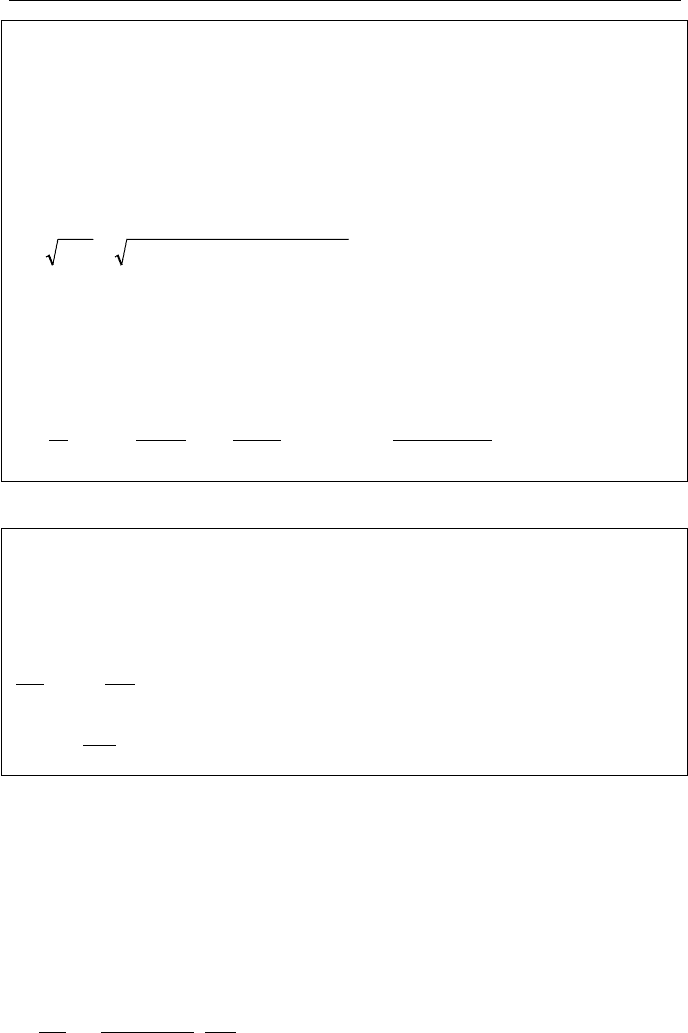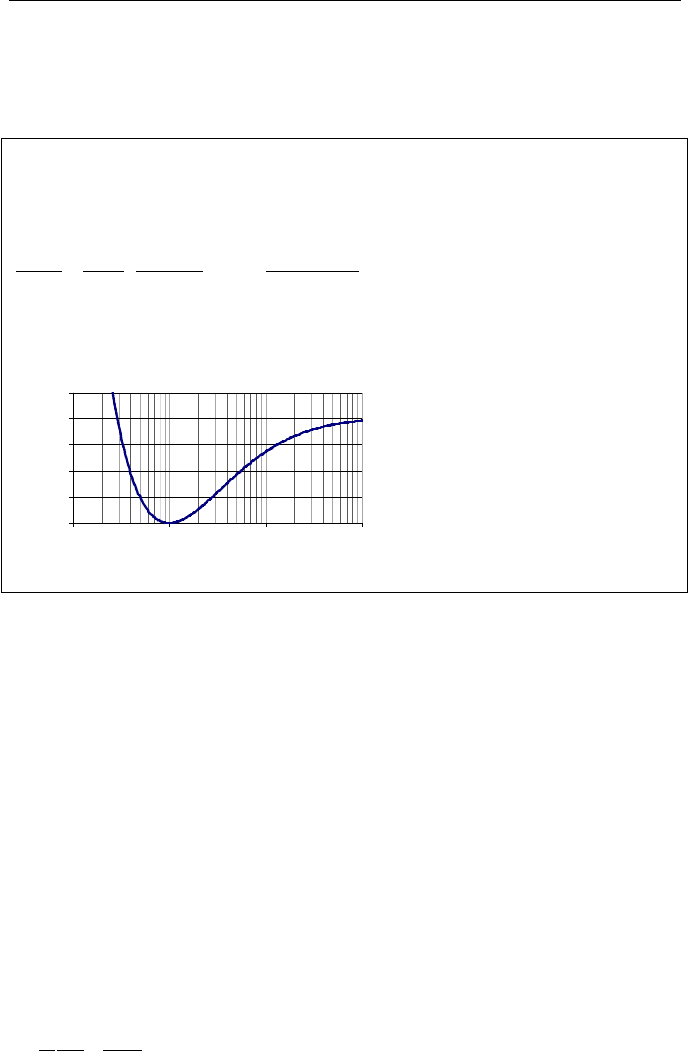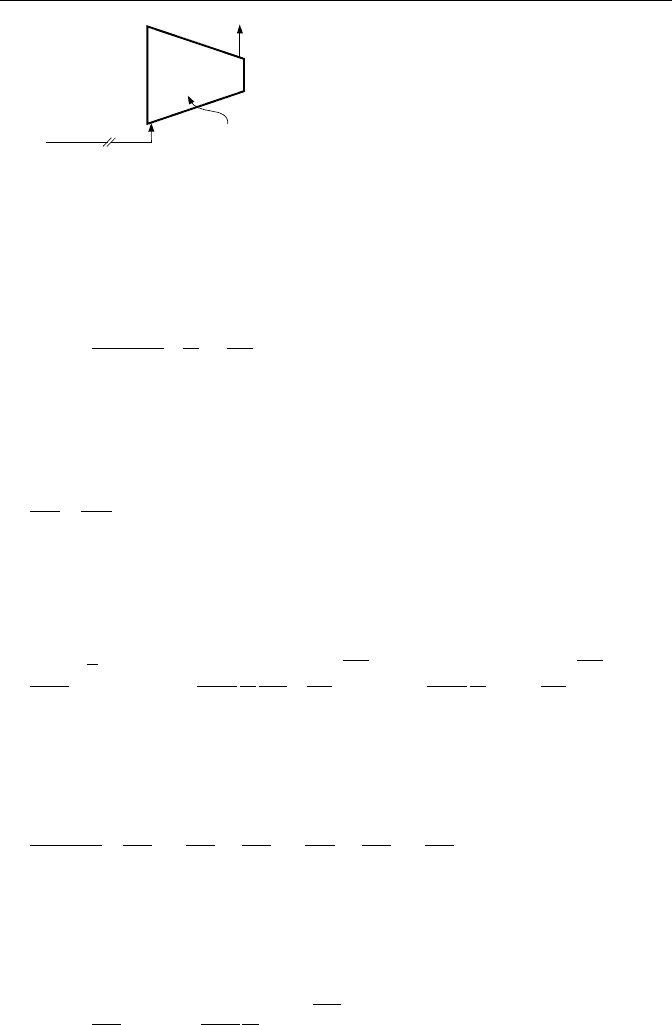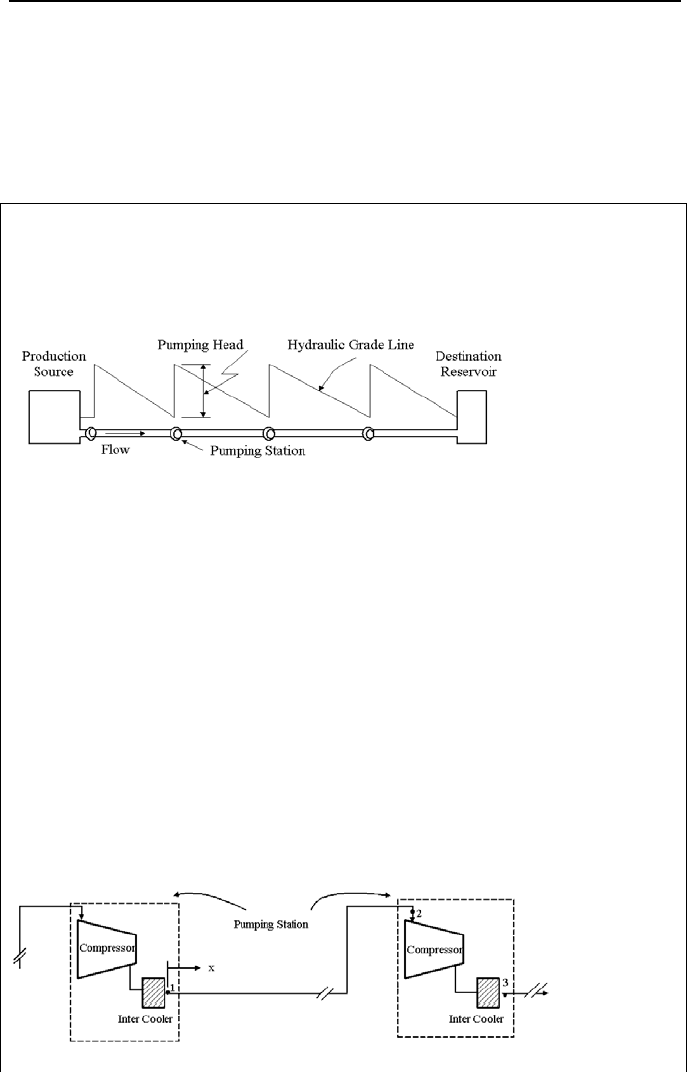Massoud M. Engineering Thermofluids: Thermodynamics, Fluid Mechanics, and Heat Transfer
Подождите немного. Документ загружается.


IIIc. Fluid Mechanics: Compressible Flow
402
A. Pressure Drop for Flow of Compressible Fluids in Pipelines,
Reduction from General Formula
Consider the flow of an ideal gas in a pipe with diameter D. If flow properties are
known at the inlet (i), we want to find flow properties at the outlet (e) for T
i
= T
e
.
We try this method only for pressure. Here, dA = 0 (pipe with constant flow area)
and dT = 0 (isothermal process). Equation IIIc.1.12 reduces to:
¸
¹
·
¨
©
§
−
+−
−
¸
¸
¹
·
¨
¨
©
§
−
−
=
RT
dF
Tc
dq
P
dP
p
2
2
2
2
Ma1
1Ma)1(
Ma1
Ma
γγ
and Equation IIIc.1.13 yields:
0
Ma1
Ma)1(
Ma1
Ma1
2
2
2
2
=
¸
¹
·
¨
©
§
−
−
−
¸
¸
¹
·
¨
¨
©
§
−
−
RT
dF
Tc
dq
p
γγ
We find (dq/c
p
T) from the second equation and substitute in the first. After sim-
plification we find:
¸
¹
·
¨
©
§
−
=
RT
dF
P
dP
1Ma
1
2
γ
If we substitute for Ma
2
= V
2
/
γ
RT, for dF = (4/
ρ
)(dx/D)
τ
w
, and for
τ
w
=
(f/4)(
ρ
V
2
/2), we get
1
2
1
2
−
¸
¸
¹
·
¨
¨
©
§
−=
V
P
D
Pf
dx
dP
ρ
IIIc.1.16
Equation IIIc.1.16 can be integrated to obtain ∆P. We will further study Equation
IIIc.1.16 in Section 2.
B. Pressure Drop for Flow of Compressible Fluids in Pipelines,
Direct Derivation
Here we derive the equation for pressure drop between two points i and e directly
from the conservation equations. These points are located at a distance L from
each other on a horizontal pipe having diameter D. For this section of pipe, as-
suming steady flow, Equation IIIa.3.28 simplifies to:
0h
1
=++
f
d
g
VdVdP
g
ρ
where dh
s
is also dropped since there is no shaft work between the points. Substi-
tuting for the frictional head loss from Equation IIIb.3.4 for a differential length dx
given as:

1. Steady Internal Compressible Viscous Flow
403
g
V
D
dx
fd
f
2
h
2
=
we obtain:
0
2
2
=++
V
D
dx
fVdV
dP
ρ
IIIc.1.17
To be able to differentiate Equation IIIc.1.17, we eliminate both density and ve-
locity. To accomplish this, we first divide through by V
2
, knowing that V ≠ 0:
0
2
2
=++
D
dx
f
V
dV
V
dP
ρ
IIIc.1.18
To eliminate
ρ
and V, we need two additional equations. First we use the continu-
ity equation. The density and velocity at any point along the flow path can be re-
lated to the given density and velocity at the production source for steady flow:
GAmAVVA
ii
===
ρρ
The second equation is the ideal gas equation of state, RTP =
ρ
/ from which,
PRT //1 =
ρ
. The first term in Equation IIIc.1.18 can be manipulated, noting
that for T
i
= T we have P
i
/
ρ
i
= P/
ρ
, to get:
iiii
i
iiii
i
ii
VP
P
VP
dPRT
VVP
dPRT
VV
dP
V
dP
)()
1
)((
1
2
===
ρ
ρ
ρ
ρ
Similarly, we manipulate the second term of Equation IIIc.1.18, using V = G/
ρ
=
GRT/P, to get:
P
dP
P
GRTdP
GRT
P
dV
V
−=−= ))(()
1
(
2
Equation IIIc.1.18 then simplifies to:
0
2
)(
2
=++−
D
dx
f
VP
PdP
RT
P
dP
ii
i
This equation can now be integrated for flow from one point to another:
2
0
() 2
ee
e
i
ii
Px
P
i
P
Px
ii
dP RT dx
PdP f
PPV D
´´
µµ
µµ
¶¶
−+ + =
³
where x
i
and x
e
are points where pressure is P
i
and P
e
, respectively and x
e
– x
i
= L.
Integrating yields:

IIIc. Fluid Mechanics: Compressible Flow
404
01ln
2
2
2
=+
»
»
¼
º
«
«
¬
ª
¸
¸
¹
·
¨
¨
©
§
−−
¸
¸
¹
·
¨
¨
©
§
−
D
L
f
P
P
V
RT
P
P
i
e
i
i
e
IIIc.1.19
where the subscript for temperature is dropped, as T
e
= T
i
. Equation IIIc.1.19 may
alternatively be written as:
()
0ln
211
=−−− ccc
ξξ
IIIc.1.19
where the dummy variable
ξ
and coefficients c
1
and c
2
are given as:
ξ
= (P
e
/P
i
)
2
2
1
/
i
VRTc =
c
2
= fL/D
In this integration, we assumed the friction factor remains constant between the
two points. This is a valid assumption as the friction factor for smooth pipes is a
function of the Reynolds number (Equation IIIb.3.3), which is in turn a function of
viscosity (Re =
ρ
VD/
µ
). For ideal gases, viscosity is only a function of tempera-
ture, which was assumed to remain constant (isothermal flow).
Equation IIIc.1.19 is a non-linear algebraic equation, which should be solved
by iteration. As the first guess, we may ignore ln ȟ, compared with the absolute
value of the other two terms, and find ȟ from:
2
2
2
Ma11
i
i
i
e
D
L
f
RT
V
D
L
f
P
P
γξ
−=−=
¸
¸
¹
·
¨
¨
©
§
= IIIc.1.20
Example IIIc.1.1. Air flows isothermally in a smooth, 1 ft (0.3 m) diameter, 1500
ft (457 m) long horizontal pipe at a rate of 7500 CFM (212.4 m
3
/min). Air enters
the pipe at 600 psia (4.1 MPa) and 300 F (149 C). Find the pressure drop in the
pipe.
Solution: At given P
i
and T
i
, air viscosity is v
i
= 1.27E-5 ft
2
/ s. We now perform
the following steps:
22
ft785.04/14.34/14.3 === DA (0.073 m
2
)
ft/s15.159)60785.0/(7500/V
1
=×== AV
(48.5 m/s)
Re / 159.15 1/1.27E 5 1.25E7;
ii i
VD v==× −=
007.0)6E88.5/(184.0Re/184.0
2.02.0
===
ii
f
. Since f
i
= f
e
, we drop the subscript.
53.51)2.32/15.159/()460300)(97.28/1545(/
22
1
=+==
i
VRTc
,
5.101/1500007.0/
2
=×== DfLc
. Therefore, Equation IIIc.1.19 becomes:
51.53ȟ – ln(ȟ) – 41.03 = 0

1. Steady Internal Compressible Viscous Flow
405
By iteration, we find;
ξ
§ 0.792. Thus, (P
e
/P
i
) = (0.792)
1/2
= 0.8899
P
e
= 0.8899 × (600) = 534 psia and pressure drop is ∆P = P
i
– P
e
= 600 – 534 = 66
psi (0.455 MPa)
If estimated from Equation IIIc.1.20, ȟ is found as:
ȟ = 1 – [0.007 × (1500/1.0) × (159.15
2
/32.2)]/[(1545/28.97) × (300 + 460)] =
0.796.
Caveat: Pressure drop associated with the isothermal flow of compressible
viscous fluids results in a decrease in the fluid density, which in turn results in an
increase in the flow velocity to preserve the specified steady state mass flow rate.
Equation IIIc.1.19 is valid only if flow remains subsonic. As is discussed in Sec-
tion 2, flow becomes sonic when dP/dL
ĺ. We then take the derivative of
Equation IIIc.1.19:
()()
()
iiei
e
PPPVRT
Df
dL
dP
/2//2
/
22
−
=
IIIc.1.21
Setting the denominator of Equation IIIc.1.21 equal to zero, we find the condition
for sonic velocity as:
RT
V
P
P
i
i
e
2
2
=
¸
¸
¹
·
¨
¨
©
§
=
ξ
IIIc.1.22
Alternatively, we may express Equation IIIc.1.22 in terms of the Ma number by
noting that:
()
()
()
()
e
i
e
i
i
e
i
e
i
e
V
V
AVm
AVm
RT
RT
P
P
Ma
Ma
/
/
/
/
====
ρ
ρ
IIIc.1.23
where we also took advantage of c
2
=
γ
RT and Ma = V/c. Substituting for the
pressure ratio in terms of the Mach number ratio in Equation IIIc.1.22, we find the
limiting Mach number:
γ
/1Ma
*
= IIIc.1.24
Thus Equation IIIc.1.19 is valid as long as the Ma number at the pipe exit remains
less than (1/
γ
)
1/2
.
Equation IIIc.1.19 may also be expressed in terms of the Ma number by using
the relation between the pressure ratio and the Mach number ratio, as given by
Equation IIIc.1.23:
»
»
¼
º
«
«
¬
ª
−
¸
¸
¹
·
¨
¨
©
§
+=
¸
¸
¹
·
¨
¨
©
§
D
L
f
e
i
i
e
i
2
2
2
Ma
Ma
lnMa1
Ma
Ma
γ
IIIc.1.25

IIIc. Fluid Mechanics: Compressible Flow
406
Example IIIc.1.2. Methane enters a pipeline at a rate of 50 kg/s. The pipe is
1200 m long, having an inside diameter of 0.5 m. Find the pipe length over which
Equation IIIc.1.19 is applicable.
Data: P
i
= 0.5 MPa, T
i
= 27 C, f = 0.015, M
CH4
= 16, and
γ
CH4
= 1.3.
Solution: We first calculate the Mach number at the pipe inlet:
A =
π
D
2
/4 =
π
(0.5)
2
/4 = 0.196 m
2
ρ
i
= P
i
/RT = 500/[(8.314/16) × (27 + 273)] = 3.207 kg/m
3
V
i
= )/( Am
i
×
ρ
= 50/[3.207 × 0.196] ≈ 79.55 m/s
=+××== )27327()16/8314(3.1RTc
γ
450 m/s
Ma
i
= 79.55/450 = 0.177
The limiting Mach number is then found as Ma
*
= (1/1.3)
0.5
= 0.877. Thus,
ξ
=
(Ma
i
/Ma
*
)
2
= 0.078
From Equation IIIc.1.25 we find:
»
»
¼
º
«
«
¬
ª
¸
¸
¹
·
¨
¨
©
§
−
−=
2
Ma
1
ln
i
f
D
L
γ
ξ
ξ
= =
»
¼
º
«
¬
ª
¸
¸
¹
·
¨
¨
©
§
×
−
−
2
177.03.1
1078.0
)078.0ln(
015.0
5.1
2008 m
Example IIIc.1.3. Express the relation for pressure drop for incompressible flow
in terms of the Ma number.
Solution: We substitute for
ρ
= P/(RT) and V
2
= c
2
Ma
2
= (
γ
RT)Ma
2
in Equa-
tion IIIb.3.7, P
i
– P
e
= (fL/D)
ρ
V
2
/2:
2
Ma
2
1
γ
D
L
f
P
P
i
e
−= IIIc.1.26
2
Ma
2
γ
D
L
fP =∆
1.3. Adiabatic Process for Compressible Fluids
Consider the same condition as discussed before. However, this time T
e
≠ T
i
but
the pipe is insulated so that dq = 0. Note that if there is also not any friction, the
problem can be easily solved using isentropic relations. However, we are consid-
ering adiabatic flow of gases with friction. To derive the formulation, we note that
for adiabatic (dq = 0) and constant area channel (dA = 0), Equations IIIc.1.13 and
IIIc.1.14 reduce to:
¸
¹
·
¨
©
§
−
−
−=
RT
dF
T
dT
2
2
Ma1
Ma)1(
γ
IIIc.1.27

1. Steady Internal Compressible Viscous Flow
407
¸
¹
·
¨
©
§
−
=
RT
dF
V
dV
2
Ma1
1
IIIc.1.28
Dividing Equation IIIc.1.27 by Equation IIIc.1.28 and substituting from Equa-
tion IIIc.1.28 yields:
¸
¹
·
¨
©
§
−−=
V
dV
T
dT
2
Ma)1(
γ
=
¸
¹
·
¨
©
§
−
−−
=
¸
¹
·
¨
©
§
−−
RT
dF
V
dV
2
2
2
Ma1
Ma)1(
Ma)1(
γ
γ
IIIc.1.29
Next, we substitute for dT/T from Equation IIIc.1.29 and for dV/V from Equa-
tion IIIc.1.28 into Equation IIIc.1.11. To deal with the dF/RT term, we find dF
from Equation IIIc.1.3 and V
2
from the definition of the Ma number dF/RT =
f(dx/2D)V
2
/RT = f(dx/2D)Ma
2
γ
RT/RT = f(dx/2D)Ma
2
γ
to obtain:
()
D
dx
f
d
»
¼
º
«
¬
ª
−
+
−
=
2
2
2
2
2
Ma
2
1
1
Ma1
Ma
Ma
Ma
γγ
IIIc.1.30
To make interesting conclusions from Equation IIIc.1.30, we also simplify
Equation IIIc.1.12 and like before substitute for dF = (4/
ρ
)(dx/D)
τ
w
,
τ
w
=
(f/4)(
ρ
V
2
/2), and
ρ
= P/RT to obtain:
2
1
Ma1
Ma)1(1
2
2
2
V
D
f
dx
dP
ργ
−
−+
−=
IIIc.1.31
Subsonic flow, Ma < 1 (dMa > 0). The pressure drop resulted from subsonic
flow of compressible viscous fluids in constant area conduits results in an increase
in the flow temperature, which combined with decrease in pressure (dP/dx < 0)
causes density to decrease (
ρ
= P/RT) and velocity (V = m
/
ρ
A) and Ma number to
increase. Thus, friction causes the subsonic flow to accelerate.
Supersonic flow, Ma > 1 (dMa < 0). The supersonic flow of compressible
viscous fluids in constant area conduits results in a decrease in Ma number and ve-
locity, requiring flow density and consequently pressure (dP/dx > 0) to increase.
Thus, supersonic flow decelerates due to friction. We further deal with this topic
in Section 2. But for now, let’s integrate Equation IIIc.1.30 from the pipe entrance
to the pipe exit:
()
[]
()
L
D
f
D
dx
fd
L
i
i
i
i
e
i
=
µ
¶
´
=
»
¼
º
«
¬
ª
−
+
+
+
+
−
=
µ
¶
´
−
−+
0
2
2
2
2
Ma
Ma
2
24
2
Ma
2
1
12
Ma1
ln
2
1
Ma
Ma1
Ma
)Ma1(Ma2
Ma12
γ
γ
γ
γ
γγ
γ
IIIc.1.32
where in Equation IIIc.1.32, we have used an average value for the friction factor
and specified Ma
e
= 1. This results in the maximum pipe length beyond which
flow becomes sonic and supersonic. Since a supersonic flow decelerates, the tran-

IIIc. Fluid Mechanics: Compressible Flow
408
sition to subsonic is followed by a shock wave. The phenomenon is similar to a
hydraulic jump for the flow of incompressible fluids in open channels where a fast
and shallow flow becomes a slow and deep flow. As a result, Equation IIIc.1.32
gives the maximum pipe length for a continuous flow.
Example IIIc.1.4. Find the L
max
/D versus Ma
2
for air. Use an average friction
factor of 0.02.
Solution: We use Equation IIIc.1.32, which for air (
γ
= 1.4) becomes:
¸
¸
¹
·
¨
¨
©
§
+
+
−
=
2
2
2
2
max
Ma2.01
.2Ma1
ln2.1
Ma
Ma1
4.1
1
i
i
i
i
fD
L
The plot shows that as Ma
2
approaches , L
max
/D asymptotically approaches
about 40.
0
10
20
30
40
50
0.1 1 10 100
Ma
2
L
max
/D
1.4. Isentropic Process of Compressible Fluids
Under the isentropic process, we discuss two topics. First, we discuss the calcula-
tion of pumping power in compressors. Second, we consider compressible flow
through Bernoulli obstruction meters. The latter topic is especially important in
the measurement of compressible flow.
A. Calculation of Compressor Pumping Power
Pumping compressible fluids is an example of noticeable change in fluid density
during a process. Let’s consider a pipeline in which an ideal gas enters at pres-
sure P
1
(Figure IIIc.1.2). Due to the frictional losses, pressure drops downstream
to P
2
. Our goal is to find the pumping power required for increasing the pressure
of a compressible fluid from pressure P
2
to pressure P
3
. In a special case, P
3
= P
1
.
For the compressor as the control volume, we use Equation IIIa.3.28 while ignor-
ing frictional pressure drop and the change in elevation from the inlet to the outlet
of the compressor:
0h
1
=++
s
d
g
VdVdP
g
ρ

1. Steady Internal Compressible Viscous Flow
409
P
3
P
1
P
2
h
s
Compressor
Figure IIIc.1.2. Isentropic compression of an ideal gas
Using subscript 2 for the inlet to the compressor and subscript 3 at the exit of the
compressor, the rate of work delivered to the compressor shaft, in terms of shaft
head is found by integrating the above equation:
»
»
¼
º
«
«
¬
ª
µ
¶
´
+
−
−=
3
2
2
2
2
3
1
2
h
ρ
dP
gg
VV
s
IIIc.1.33
If heat transfer in the compressor is neglected, the compression process between
points 2 and 3 becomes adiabatic. Since we also assumed no frictional losses in
the compressor, we can write:
γγ
ρ
ρ
P
P
=
2
2
Therefore,
γ
ρρ
/1
22
)/)(/1(/1 PP= and upon substitution, the second term on the
right side of Equation IIIc.1.33 becomes:
»
»
»
¼
º
«
«
«
¬
ª
−
¸
¸
¹
·
¨
¨
©
§
−
=
»
»
»
¼
º
«
«
«
¬
ª
−
¸
¸
¹
·
¨
¨
©
§
−
=
−−
³
1
1
1
1
1
1
1
1
2
3
2
1
2
3
2
2
3
2
/1
1
2
2
γ
γ
γ
γ
γ
γ
γ
γ
ργ
γ
ρ
P
P
RT
gP
P
P
g
dPPP
g
The first term in the right side of Equation IIIc.1.33 can also be rearranged to ob-
tain:
)1(
2
)1(
2
)1(
22
2
2
2
3
2
1
2
2
2
3
2
3
2
3
2
2
2
3
2
2
2
3
P
P
g
V
g
V
V
V
g
V
g
VV
−=−=−=
−
ρ
ρ
Note that conditions at point 3 must be identical to conditions at point 1. Substi-
tuting for the first and the second terms in the right side of Equation IIIc.1.33, the
required shaft head is calculated as:
»
»
»
¼
º
«
«
«
¬
ª
−
−
+−−=
−
)1(
1
1
)1(
2
h
1
2
2
2
1
γ
γ
γ
γ
rRT
g
r
g
V
s
IIIc.1.34

IIIc. Fluid Mechanics: Compressible Flow
410
where the compression ratio r = P
3
/P
2
. Finally, the pumping power is determined
from:
ss
gmW h
= IIIc.1.35
where
m
is the mass flow rate of the compressible fluid through the compressor.
Example IIIc.1.5. Transferring natural gas by pipelines from the production
source to a distant destination is accomplished by providing multiple pumping sta-
tions connected in series and located at equal distances along the path between the
production source and the receiving reservoir, as shown in Figure IIIc.1.3.
Figure IIIc.1.3. Cross-country pipeline for delivery of natural gas
In each pumping station, gas is compressed and pressurized to compensate for the
frictional losses in the pipeline until the next pumping station. The pressurization
and the cooling of inter-coolers bring pressure and temperature to the values
where gas first enters the pipeline from the production source.
a) Find the pressure drop in the pipeline between the successive pumping stations
and b) find the pumping power for each pumping station for given pipe diameter,
flow rate ( m
), pressure (P
1
), and temperature (T
1
) at the production source.
Data: Natural gas is compressed to P
1
= 120 psia (0.827 MPa), then cooled to the
ambient temperature of T
1
=80 F (26.67 C), as shown in Figure IIIc.1.4. Gas then
enters the pipeline at a velocity of 45 ft/s (13.72 m/s). The pipe has an inside di-
ameter of 2.25 ft (68.6 cm). The pumping stations are located every 15 miles
(24.14 km). Natural gas (considered as methane) molecular weight is 16, its ki-
nematic viscosity at 80 F (26.67 C) is about 2.62E-5 ft
2
/s (2.434E-6 m
2
/s), and γ =
c
p
/c
v
= 1.3.
Figure IIIc.1.4. Pumping stations for pressure recovery

1. Steady Internal Compressible Viscous Flow
411
Solution: a) We assume ideal gas behavior for natural gas, uniform properties at
each cross section, and negligible changes in elevation. We find frictional pres-
sure drop at 15 mile intervals from Equation IIIc.1.19, assuming isothermal flow
in the pipe:
Re = VD/v = 45 × 2.25/2.62E-5 = 3.864E6. Hence, f = 0.184/Re
0.2
= 0.00886 (for
smooth pipe)
c
1
= RT
1
/
2
1
V = (1545/16) × (460 + 80)/(45 × 45/32.2) = 829.15
c
2
= fL/D = 0.00886 × (15 × 5280)/2.25 = 311.87
829.15ȟ – ln ȟ – 517.28 = 0
By iteration (or simply ignoring ln
ξ
) we find
ξ
≈ 0.6233. Hence, P
2
/P
1
=
ξ
1/2
=
(0.6233)
1/2
= 0.7895. Therefore, P
2
= 0.7895(120) = 94.74 psia and ∆P = 120 –
94.74 = 25.26 psi (0.174 MPa).
b) The pumping power is needed to compensate for the unrecoverable pressure
loss over the 15 miles of piping between successive pumping stations. Pumping
power is given be Equation IIIc.1.34 and IIIc.1.35:
»
»
»
¼
º
«
«
«
¬
ª
−
−
+−−=
−
)1(
1
)1(
2
1
2
2
2
1
γ
γ
γ
γ
rRTr
V
mW
s
where
A =
π
D
2
/4 = 3.14×(2.25)
2
/4 = 3.976 ft
2
(0.369)
R = R
u
/M = 1545/16 = 96.56 ft·lbf/lbmole·R (0.519 kJ/kmol·K)
ρ
1
= P
1
/RT
1
= 144×120/[96.56(460 + 80) = 0.331 lbm/ft
3
(5.3 kg/m
3
)
== AVm
11
ρ
0.331×45 ×3.976 = 59.22 lbm/s (26.86 kg/s)
r = P
3
/P
2
= P
1
/P
2
= 120/94.74 = 1.267
2
20.3/1.3
45 1.3
59.22[ (1 1.267 ) 96.56(460 80)(1.267 1)]
2 32.2 0.3
W =− − + + − =
×
–7.5E5 ft·lbf/s (–1 MW)
B. Flow Rate Measurement of Compressible Fluids
In measuring flow rate of compressible fluids with Bernoulli obstruction meters,
we must take into account the compressibility effect, due to the noticeable change
in the density of the compressible fluid through such devices. The pressure drop
associated with the flow of compressible fluids, especially through a thin-plate ori-
fice, causes the flow to expand adiabatically and density to decrease downstream
of the throat. Our goal is to find an expression similar to Equation IIIb.4.4, that
was derived for the mass flow rate of incompressible fluids. Recall that in the
derivation of Equation IIIb.4.4, which was based on Equation IIIa.3.33, we used
the Bernoulli equation. Here, however, due to the change in the fluid density, we
cannot use the Bernoulli equation. We then start with the energy equation. To
begin the derivation, consider flow through the venturi of Figure IIIb.4.3 where
